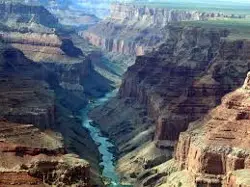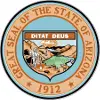The Making of the 50 States: Arizona
Exploration continued as well. John Wesley Powell sailed down the Colorado River in an exploration of the Grand Canyon. As well, tens of thousands of people had traveled through the southern part of Arizona in 1849 and later years during the California Gold Rush, stopping and resupplying at Arizona settlements along the way. 
As in many other states, the more American settlers arrived, the more they went to various lengths to convince Native Americans to leave their ancestral homes. One of these forced relocations has come to be known as the Long Walk of the Navajo, which was several dozen forced marches that resulted in many deaths and much ill will. The U.S. Army had built a number of forts to protect American settlers. Among these forts were Fort Apache, Fort Defiance, and Fort Huachuca. An Apache force led by Cochise attacked a group of American soldiers at Apache Pass in 1862; this was the start of a ten-year war with settlers. In 1864, famed explorer Kit Carson led an armed force that captured thousands of Navajo and forced them to leave the state. The third and final surrender of famed Apache leader Geronimo, in 1886 in what is now Arizona, ended the Apache Wars. Another famous event in Arizona and American history was the Gunfight at the O.K. Corral, which occurred on Oct. 26, 1881. The shootout took place in Tombstone, a mining town known for its lawlessness. 
Arizona is home to the Grand Canyon, which was made a national monument in 1908 and a national park in 1919. The laying of railroad track to the South Rim of the Grand Canyon was complete in 1901, and entrepreneurs seized on the opportunity to build a hotel and restaurant. This was the famous and luxurious Harvey House. 
In 1906, residents of both the Arizona Territory and the New Mexico Territory voted on a proposal for statehood for the two territories to be combined into one state. A majority in New Mexico voted for the measure, but a majority in Arizona voted against, so the measure did not pass. The two territories then went about their separate business of statehood. Arizona became a state on Feb. 14, 1912; the capital was Phoenix (the territorial capitol since 1889). First page > In the Beginning > Page 1, 2 |
|
Social Studies for Kids
copyright 2002–2024
David White




